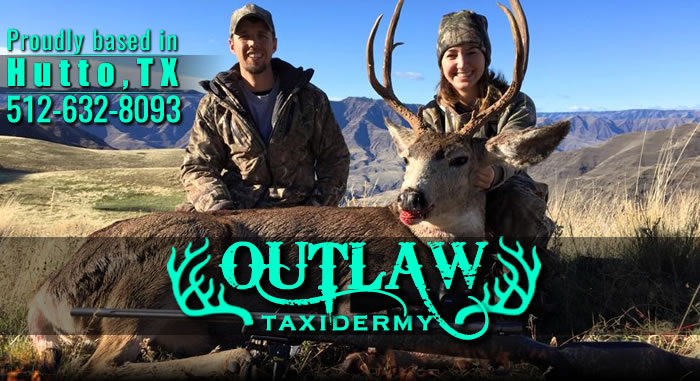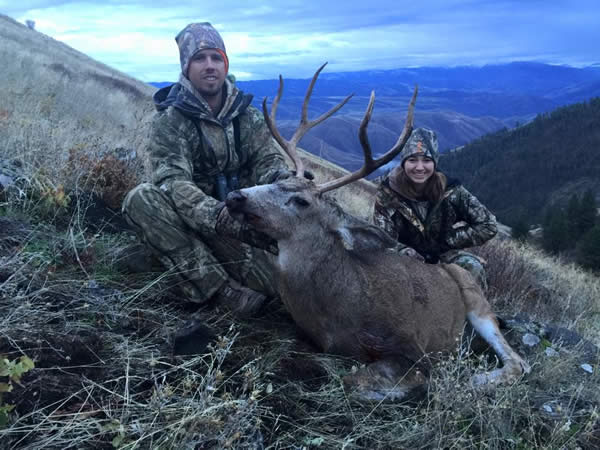Q- Where do I cut a trophy for a shoulder mount?
We suggest you take a hands length after the front leg and cut around the whole animal, then cutting behind the front legs to get the legs free. Depending on what type of animal and what type of mount.
Q- How can an animal get freezer burn?
The loss of moisture from tissue. We prevent this by adding more water.
Q- Should I skin out the whole animal?
No, if its big game skinning it out to the neck is sufficient, then leave the rest for the taxidermist to take care of.
Q- How do I skin out a turkey or other bird?
Easy, take it to your taxidermist A.S.A.P. or freeze it then take it to him. If you’re going to get a turkey mounted you don’t want to skin it because a holey turkey could cause the price to increase for the mount. If you need to freeze it…..Soak it in water and wrap it in newspaper, then soak the whole thing in more water again. Place it in a plastic bag and freeze it till you bring it to the shop. This should go for any small game.
Q- How do I transport the mount?
Lay the mount down with the nose facing upward resting on the back of the antlers and the upper base of the neck. Place the mount on a padded surface and pad the area sufficiently to prevent the mount from shifting during transport. Pillows work well. Always carry the mount with two hands: One hand should grasp each antler or better yet, one hand can gently hold the throat with the other hand on the brisket.
Q- How do I Hang the mount?
The mount should be hung from a sturdy nail or screw, which should be firmly anchored into a wall stud. Never trust your mount to a drywall hanger. It looks neater to tuck the hair at the base behind the back of the mount. Do not hang your mount in an area prone to excessive heat or temperature swings. Your mount will last longer if displayed in an area where the humidity is kept between 30% and 70%. Avoid a display area with direct sunlight. Smoking or other airborne pollutants can result in "yellowing" and cracking of the mount over time.
Q- How do I do proper Field Care
First, shoot the animal through the chest. A carefully aimed shot just behind the shoulders is best, because it ruins less meat and will not damage the cape allowing the taxidermist to create a more lifelike head mount. Don't finish off the animal by shooting it in the neck or head, instead, finish it off with a shot through the chest, which will better allow it to bleed out. Taxidermists certainly appreciate a cape that was cared for property. Please don't slit the throat on the deer as this leads to unnecessary cape damage. When field dressing the animal, don't cut past the sternum. Be gentle while recovering the animal from the woods. Avoid dragging it on the ground; better to use a Jet Sled or ATV to get him out and protect the hide. For the best mounting quality, take the deer straight to the taxidermist or processor for skinning ASAP. If you must hang your deer, please don't hang it with a rope around its neck, instead, hang it by the antlers or hind legs. Keep in mind that hanging the animal by its antlers will cause the spread of the rack to narrow slightly reducing it's record book score. Make sure to tell your deer processor or butcher that you want the animal skinned for a head and shoulder mount. If you skin the deer yourself, be careful not to make any unnecessary cuts. Tube the skin up the chest and neck, leaving plenty of hide behind the shoulder for the taxidermists. Cut the front legs off at the knee and tube the skin off the legs without any cuts. Cut the head off at the base of skull being careful not to cut the hide with the saw. To avoid freezer burn, roll up the cape, skin side in; put it in a garbage bag tying it off between the antler bases to cover the ears, eyes and nose; then freeze it. If you can't freeze the cape, roll it up inside a burlap bag or commercial game bag and then store it in a cold, well ventilated place. For best mounting results, get the cape to the taxidermist ASAP. Use safety pins to tag game instead of cutting holes in the ears.
Q- What can I do to keep my mount maintained or looking new?
Use a feather duster to remove dust. For bears, mink, squirrels, and similar furbearers, they should be vacuumed with a hose attachment and groomed with a brush. Many of these animals should be groomed backwards to allow the hair to lay naturally and not matted down. Gently wipe in the direction of the fur with a product called Mount Protect . It has a pleasant scent that repels moths and bugs. It also adds shine to the fur. Groom when the mount is dry. You can also take a paper towel or regular towel and spray some Windex on it and wipe your trophy gently in the direction of the fur, or feathers. A taxidermist can also professionally clean older mounts.
Q-Are there any options available for my mount?
Options can include a decorative plaque, realistic habitat, an end or coffee table diorama, or a modern, artistic pedestal base. The only limit to how your trophy can be presented, is your imagination. If you are looking for a truly special mount I have many different resources for ideas on how to customize your mount. Many options can be added to previously mounted specimens to add beauty and value to older mounts.
Q- Am I open on weekends?
Yes, but only by an appointment. I need time to go hunting and fishing too! J
Q-What are the best methods for mounting?
Good taxidermy starts with good materials. We use only the best materials available to recreate your trophies. From that point, previously recorded measurements are the key. It is rare to buy a commercial manikin that will fit your trophy properly. We alter our manikins to fit your trophy, so it will look as real as possible. Tanning of a hide is also extremely important. There are faster, less expensive ways to preserve a skin, but these mounts do not have the longevity or elasticity of a tanned skin. When mounting a trophy we rely heavily on reference materials. These can be live animal studies, photographs, castings, models, and videos of live specimens. By applying knowledge gained from reference we can produce more accurate mounts that will be as real as possible and beautiful for years to come.
Q- Does sunlight affect my trophy?
Absolutely, direct sun will cause discoloration in the hair, and feathers, no nutrients to those parts leaves them susceptible to sun’s rays, just like sheds you find in the woods, after a while they turn bleach white.
Q- How should I transport my trophy from the place I harvested it to the taxidermy shop?
You should skin out the trophy up to the neck, and freeze it, or if it will be more than a few days and freezing it will be an issue, skin out the whole animal and you’ll have to make sure at least 80% of the fat and meat is off the skin and then salt it (non-iodized salt) After you salt it and let it dry for a few hours hang it up so more of the fluids can drain out of the skin (preventing bacteria beds to form) which causes hair to slip. If you have to skin the head out, please take your time and follow the bone contour of the head as closely as possible. If you haven’t done it, and don’t feel comfortable let someone else that has done it do it.
Q- Does cigarette smoke affect my trophy?
Absolutely, the chemicals in the smoke cause the hair or feathers to get a discoloration, a tavern yellow look, it can be somewhat fixed but not completely.
Q-Can you mount my pet?
Yes. Pets can be mounted. It can be very expensive to mount pets because there are no commercial products available. Therefore, every part of the mount will have to be made custom. Custom parts can take many hours to make. Each mount will need to be researched before a price can be determined.
Q -Can you mount an animal I shoot from Africa or another exotic hunting trip?
Contact me before going to Africa or out of the country so I can set you up with shipping tags and get everything set up through an importer. All of this is complimentary ....no charge. Specializing
Q-Can you mount this owl I found on the side of the road?
No. I can’t legally mount any protected animals without proper permits. Songbirds, owls and other birds of prey are protected species. Songbirds and birds of prey can be mounted with a special permit obtained from the federal government. Some learning institutions are granted permits for educating others about wildlife. Permits for home use are difficult to obtain. |


